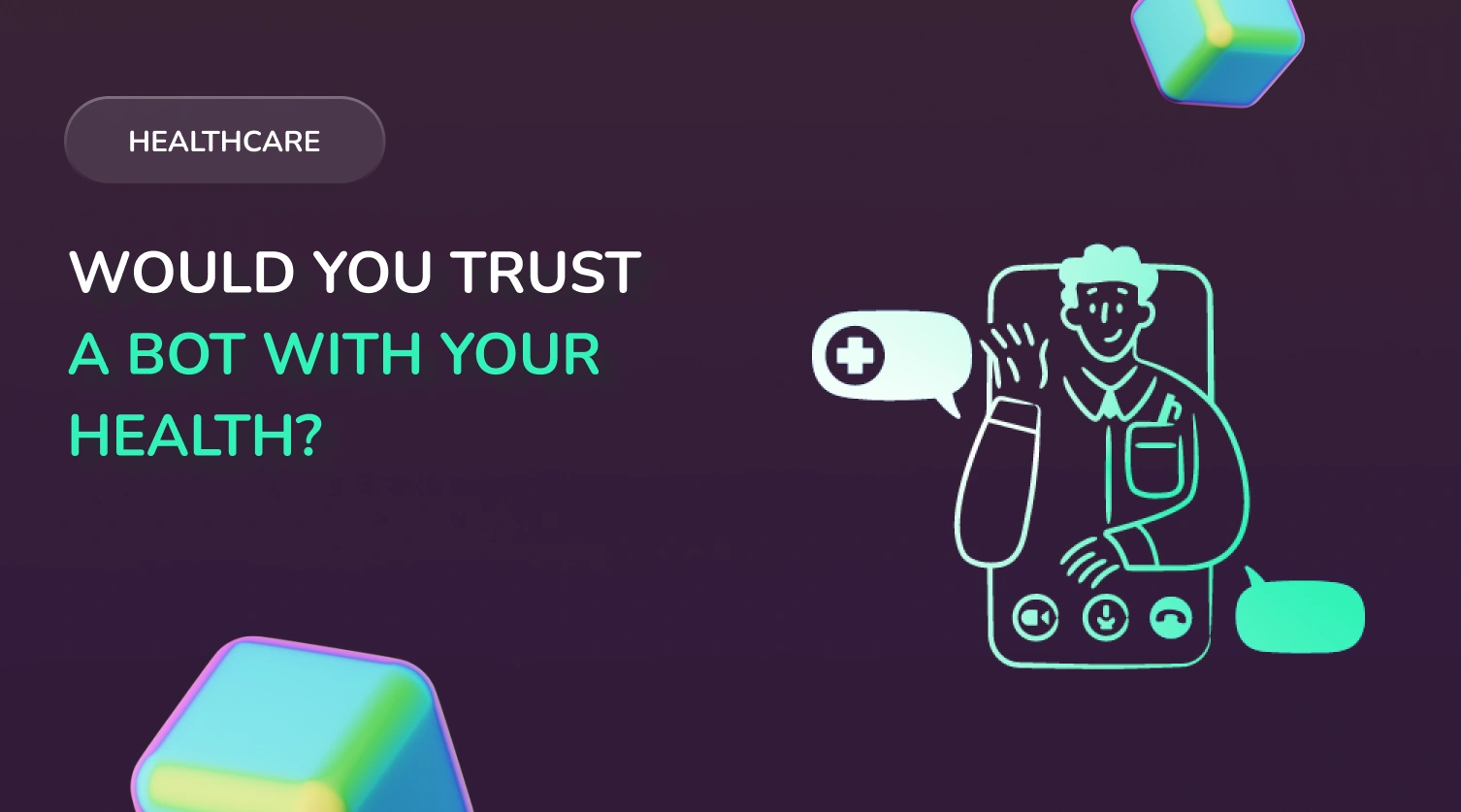
Take a moment to stop thinking like a healthcare business owner and imagine yourself as a patient. Think back to the last time you tried to book an appointment with a doctor. How long did you wait for a response? How much back-and-forth was involved in confirming the details and choosing a suitable time? If the process was slow or frustrating, maybe you even gave up and decided to try later.
Imagine how many patients could receive faster help if these basic tasks were automated.
This situation is all too common today. Patients now expect instant feedback, a personalized approach, and 24/7 access to healthcare services. And in a fast-moving world of growing competition and constant tech progress, clinics that fail to adapt risk being left behind.
That’s why healthcare software modernization has become more than just a trend — it’s necessary. Improving the patient experience, increasing operational efficiency, and staying competitive all depend on smart, timely action. One key part of healthcare modernization is moving away from outdated processes and addressing the limitations of legacy systems in healthcare.
This article will explore how AI chatbots can transform your clinic’s communication and workflow. They’re not just a convenience but a powerful tool for improving engagement, streamlining services, and providing faster care.
What Are AI Chatbots and Why Do They Matter for Your Healthcare Business
As mentioned earlier, reaching a medical clinic can be surprisingly tricky. Sometimes the line is busy, sometimes no one picks up, and other times you’re told to call back in ten minutes. Now, imagine a parent getting anxious about a rash on their child or a suspicious spot on their own skin. They don’t want to wait — they want answers now. And if they don’t get those answers from your clinic, they will get them from a competitor.
That’s exactly where AI chatbots come in. Think of them as virtual assistants for your business. Many people, maybe even you, still underestimate the power of artificial intelligence. And that’s fair — everyone has different opinions. But technology continues to evolve, and today’s AI is trained to hold natural, human-like conversations, answer frequently asked questions, schedule appointments, send reminders, and even provide initial recommendations based on symptoms. And it does this 24/7 — without breaks or fatigue — effectively replacing the limits of the human factor.
This type of digital tool is an essential part of healthcare software modernization, helping clinics improve the way they interact with patients.
What Can a Modern AI Chatbot Do in Healthcare?
| Function | Business Benefit |
| 🌙 24/7 Support | Patients get help and answers at any time of day |
| 📅 Auto-scheduling & Reminders | Fewer missed appointments and no-shows |
| 🩺 Info on Symptoms & Services | Simplifies first contact and reduces workload for admins |
| 💬 Feedback Collection | Helps identify weak spots and strengthen the patient experience |
AI chatbots aren’t just robots on a website — they’re a strategic part of patient care and business optimization. They can handle dozens of requests at once, meaning patients don’t have to wait. They reduce the pressure on your administrative staff and allow your team to focus on more complex cases and in-person service.
More importantly, AI chatbots don’t forget, don’t get tired, and they learn from every new interaction. That means they’re getting smarter, more effective, and more valuable to your clinic every day.
Integrating such a tool is a key step in healthcare modernization, especially for businesses still using legacy systems in healthcare. While older tools may have served well in the past, they simply weren’t designed for today’s patient expectations.
It’s time to move forward with smarter solutions. Based on the latest insights on healthcare modernization, AI chatbots are already proving to be essential for clinics that want to provide high-quality service while staying efficient.
If your clinic is still depending on legacy healthcare systems, consider the cost of delays, errors, and missed opportunities. Today’s patients demand more — and so do your competitors.
That’s why healthcare technology workflow modernization is no longer optional. It means streamlining how your team works, reducing manual tasks, and speeding up patient service. AI chatbots are a perfect example of how new tools can modernize and strengthen your workflow.
Don’t let legacy healthcare solutions hold your clinic back. To stay competitive and responsive in this digital age, every clinic needs to focus on healthcare infrastructure modernization. By building a strong and flexible foundation, you open the door to faster, smarter, and more scalable care.
In short, adopting AI chatbots isn’t just a trend — it’s a smart move that gives your clinic a real competitive edge. It’s about speed, scalability, and delivering the level of service your patients already expect.
How AI Chatbots Improve Real-Time Patient Satisfaction
Once, a small private clinic owner came to us with a common problem: patients complained that they couldn’t reach the clinic, administrators were overloaded, and reviews often mentioned words like “inconvenient” and “too slow.” But this wasn’t about staff doing a bad job — it was about the experience patients expect today. And they value that experience as much as the diagnosis.
That’s precisely where AI chatbots show their full potential, becoming a powerful tool in healthcare software modernization.
🤖 Instant Answers Without Waiting on the Line
AI chatbots respond within seconds. The patient doesn’t wait on hold or click through multiple pages. They simply ask: “How can I make an appointment?”, “Can I get lab tests on Saturday?”, or “What should I do if the rash doesn’t go away?” — and get a clear, helpful answer right away.
This kind of speed and availability is now a key part of healthcare modernization. It reduces the patient’s frustration and makes the whole process smoother.
💬 Reducing Stress and Anxiety
In healthcare, context and empathy are especially important. When someone messages at 10:30 p.m. saying, “My child has a fever and a rash — what should I do?”, they’re not looking for a cold fact sheet. They want to feel heard.
Modern AI chatbots are trained in a soft, human-like communication style. Using advanced neural network algorithms, they adapt their tone to the patient’s emotional state.
For example:
“I understand this may feel worrying. Here’s what you can do right now…”
This emotional support becomes even more critical when clinics still rely on legacy systems in healthcare that don’t allow real-time or sensitive communication.
🔄 Personalized Conversations
AI chatbots don’t just give generic answers. They remember the context of the conversation. If a patient has already asked about a dermatologist, the chatbot won’t suggest an ENT doctor. It adjusts the language and tone to fit the patient’s communication style and guides them through every step, from booking to reminders.
This level of care reflects modern insights on healthcare modernization and shows how deeply technology can improve the patient journey.
📱 Support on All Devices
Whether it’s a website, messenger, or mobile app, patients get help wherever it’s convenient, without needing to download anything or go through long logins.
This becomes a must when replacing legacy healthcare systems that lack mobile optimization or easy access.
🧠 Results You Can Feel, Not Just Measure
When patients feel heard, supported, and guided, they’re not just satisfied — they stay with your clinic. This directly impacts return visits, word-of-mouth recommendations, and online reviews, all of which shape your clinic’s reputation in the digital world.
By focusing on healthcare technology workflow modernization, clinics can streamline communication and remove friction from patient interactions. The result is not just improved metrics but a real, emotional connection with your patients.
Even if your clinic still uses legacy healthcare solutions, integrating AI chatbots is a smart way to upgrade the patient experience without needing to rebuild everything from scratch. It’s a powerful first step toward healthcare infrastructure modernization, helping you stay competitive and patient-focused in a fast-changing environment.
Common Concerns: Are AI Chatbots Safe and Reliable?
When it comes to health, trust means everything. So it’s no surprise that one of the first questions we hear from clinic owners is:
“Is it safe? We’re dealing with personal medical data!”
And that’s a very fair question.
Patients often share their most sensitive information — symptoms, diagnoses, and medical histories. A single data leak could lead to legal trouble and damage the reputation that clinics have built through years of quality care and trust.
That’s why AI chatbots in healthcare are developed following strict privacy and security standards, such as GDPR (in Europe) and HIPAA (in the U.S.). These regulations define how personal data is processed, stored, and protected. Responsible developers build in end-to-end encryption, access controls, version tracking, and continuous security monitoring as part of healthcare software modernization.
What Makes an AI Chatbot Reliable?
| Feature | How it Works for You and Your Patients |
| Data Encryption | All messages are encrypted and protected from third parties |
| Access Audit & Logs | Every action is tracked, so you always know who accessed what |
| Verified Data Training | Reduces the risk of misleading or “hallucinated” answers |
| Constant Updates | The chatbot keeps learning and improving accuracy |
| Function Limitations | It doesn’t diagnose — it guides patients to the right specialist |
It’s important to remember: an AI chatbot is not a doctor. It’s a communication tool. It doesn’t make final decisions or replace medical judgment. Its role is to guide, support, and speed up contact, while staying within legal and ethical boundaries. This is an essential part of healthcare modernization.
Yes, both people and systems can make mistakes. But the key difference is that every AI chatbot mistake becomes a data point — it learns, adapts, and improves much faster than any human could. This makes it a powerful addition, especially in clinics still relying on legacy systems in healthcare.
For business owners, implementing AI is not a risk — it’s an opportunity to improve security and streamline communication through modern technology.
The main point? Work with experienced partners and don’t cut corners when it comes to sensitive systems. These insights are at the heart of effective healthcare modernization.
How to Implement an AI Chatbot Without Technical Knowledge
During recent calls with private clinic owners, one phrase keeps coming up:
“This sounds great, but I’m not technical. Is this really for me?”
Spoiler: It’s exactly for you.
Today, setting up an AI chatbot doesn’t require coding, a technical background, or sleepless nights with developers. All you need is a clear understanding of your audience and the desire to improve patient experience. The rest is on us.
Modern plug-and-play chatbot solutions are like hiring an experienced staff member — except it never takes sick days. Everything is handled by our team, including integration with your systems, which helps bridge the gap between legacy healthcare systems and more efficient tools.
What the Setup Looks Like
| Step | What Your Business Gets |
| Business Analysis | We study your funnel, patient pain points, and communication flow |
| Scenario Setup | We create real, human-like dialogues based on your clinic’s tone |
| CRM Integration | Chatbot syncs automatically with your calendar and booking tools |
| Team Training | Your staff understands how to manage the chatbot with ease |
| Analytics & Support | You see how the chatbot affects inquiries, appointments, and reviews |
You don’t need to worry about technical details. You just see the chatbot answering questions, helping patients book appointments, and supporting your team.
👉 For example, in one of our projects, we implemented an AI chatbot in an online clinic. The owner had no IT background, but within two weeks of launch, the chatbot handled up to 63% of initial patient inquiries. As a result, administrators focused on more complex cases — reducing delays, increasing satisfaction, and improving return visits.
If you want to simplify patient communication, reduce the workload on your team, and increase appointment requests, technical knowledge isn’t required. What you need is the right partner.
At Corpsoft Solutions, we specialize in projects like this. We dive deep into your business, handle the tech side completely, and help you benefit from healthcare technology workflow modernization — without the headache of tech jargon.
Even if you’re still using legacy healthcare solutions, AI chatbots are an accessible first step in your healthcare infrastructure modernization journey. Let technology work for you, not against you.
The Metrics That Truly Matter. How to Measure the Success of an AI Chatbot in Healthcare
When talking to clinic owners, we often explain that implementing AI solutions should not be seen as just another “digital toy” for the website — it’s an investment in growth, long-term efficiency, and scalable success. It’s about building a healthcare system that is ready for the future. And like any serious investment, this one must deliver measurable results.
With that in mind, tracking the right metrics is essential. Below, we share the key indicators we recommend monitoring to evaluate the real impact of your chatbot, especially during healthcare software modernization efforts.
1. Patient Satisfaction Score (NPS)
Net Promoter Score is a simple but powerful tool to measure patient loyalty and satisfaction. We suggest measuring NPS before and 1–2 months after chatbot implementation. In our healthcare modernization projects, clinics often report a 15–30% increase in NPS, thanks to faster and more personalized digital communication. This is especially important when replacing or upgrading legacy systems in healthcare that lack user-focused interaction.
2. Reduction in Call Center Load
One of the most immediate results is a visible drop in call volume. After launching the AI chatbot, clinics usually see a 30–50% reduction in incoming calls, particularly on routine topics like office hours, pricing, or rescheduling. These insights on healthcare modernization help management see where automation has the biggest impact — freeing up staff to handle complex issues and reducing operational costs. It’s also a strong argument for retiring legacy healthcare systems that consume too many resources.
3. Average Response Time
Before implementation: 3–10 minutes (sometimes more). After implementation: 1–3 seconds. This drastic improvement not only boosts the patient experience but also speeds up decision-making. Such instant support is a cornerstone of healthcare technology workflow modernization, helping clinics become more agile and responsive.
4. Website Conversion Rate
This shows how many visitors turn into real patients. Adding a chatbot with booking functionality can increase conversion rates by 12–25%. Why? Because visitors get help at the exact moment they need it — without leaving the page. These numbers clearly show how replacing outdated legacy healthcare solutions leads to higher engagement and ROI.
5. Number of Completed Appointments via Chat
This is a direct sign that the chatbot is not just “chatting” but working. In successful cases, bots handle 40–60% of all online bookings, especially during evenings and weekends when live staff are unavailable. It’s one more benefit of healthcare infrastructure modernization, showing that digital tools can operate reliably even during off-hours.
What’s Next? AI Chatbots Will Only Get Smarter
AI chatbots in healthcare are just the beginning. What seems revolutionary today will soon become the standard. Here’s where the future is headed — and why healthcare software modernization is more than just a trend.
1. Hyper-Personalization
AI can already remember patient preferences, adjust its communication style (formal, friendly, or straight to the point), and personalize recommendations based on previous questions. Soon, it will go even further — for example, suggesting appointment times based on past visits or how often the patient contacts the clinic. These advancements are key parts of healthcare modernization that improve the overall experience.
2. Real-Time Patient Behavior Analysis
In the near future, chatbots will do more than just answer questions — they’ll predict user intentions. They may detect signs of anxiety, low mood, or a drop in treatment interest. This allows for timely human intervention or gentle support scenarios, which can increase loyalty and improve clinical outcomes. Moving away from outdated legacy systems in healthcare will make such intelligent features easier to integrate.
3. Voice Interfaces and Multi-Channel Access
Very soon, patients may simply say, “Book me with a dermatologist this Friday,” and the chatbot will do the rest. Integration with voice assistants and messaging apps will make healthcare services accessible even to those who dislike typing in chats. These are clear insights on healthcare modernization that point toward more convenient and inclusive digital care.
🚀 Scaling Without Extra Costs
The biggest benefit? Scalability. An AI chatbot doesn’t need time off, doesn’t get tired, and never loses its tone — it can assist thousands of patients at once, 24/7. For clinics with growth plans, this is a powerful tool, especially when replacing legacy healthcare systems that limit flexibility.
By embracing healthcare technology workflow modernization, clinics can:
- Serve more patients efficiently
- Reduce manual work by up to 60%
- Maintain a stable flow of appointments
- Gain a competitive edge over clinics still relying on phone calls
Now Is the Time to Act
More satisfied patients. Less routine work. Higher profits.
All this becomes reality with a well-implemented smart AI chatbot. But the tool alone is not enough — what matters is how it’s integrated, from workflow setup to CRM connection and staff support. That’s why it’s essential to work with a partner who understands not only the tech but also the goals behind your medical project.
Whether you’re looking to replace legacy healthcare solutions or move toward full healthcare infrastructure modernization, we’re here to help.
Subscribe to our blog

